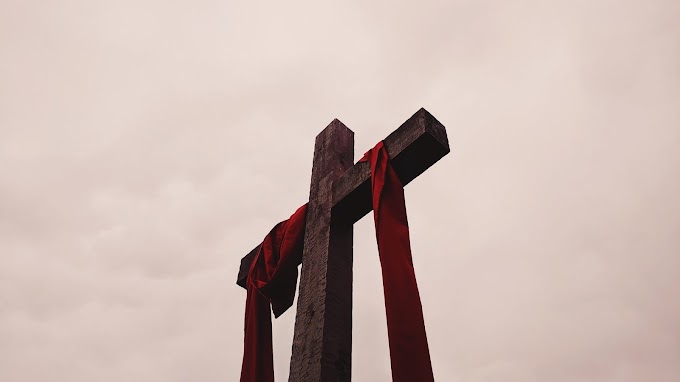According to the timeline of Bible prophecy, there’s an extremely nasty woman—a woman not without allure however—about to appear on the world’s stage. It isn’t Jezebel, the Old Testament queen invoked as the epitome of libertine living, seduction and evil. This woman is far worse.
The woman we can expect to see making her stage debut at the close of earth’s history is described by the disciple John who writes in the New Testament about a vision he had. In this vision he saw a woman: “. . . sitting on a scarlet beast that was covered with blasphemous names and had seven heads and ten horns. The woman was dressed in purple and scarlet, and was glittering with gold, precious stones and pearls. She held a golden cup in her hand, filled with abominable things and the filth of her adulteries. The name written on her forehead was a mystery: Babylon the Great, the Mother of Prostitutes and of the Abominations of the Earth” (Revelation 17:3–5, italics added).
You know you’re dealing with a tough character when she has a face tattoo that reads “Mother of Prostitutes”! Unfortunately, the Great Whore of Babylon’s identity has been one which has confounded many biblical scholars. So who exactly is she and how should we respond when she appears?
Some think they have recognised her in the pop star Madonna! Truly, her music video for “The Beast Within” could excuse you for thinking so, but no matter how much you dislike “Papa Don’t Preach,” Madonna is probably not central in the apocalypse.
Another candidate has been spotted by the internet’s Pastor Ezekiel, who describes himself as putting the “stud” back in Bible study. The handsome pastor has determined that this bad girl of Revelation has to be “Hell-ary Clinton.”
Another former First Lady has also been named as a suspect. “Michelle Obama must be the Whore of Babylon,” declared Pastor Franklin Graham, son of America’s most famous evangelist, Billy Graham. In an interview with the Conservative Chronicle, the younger Graham described the similarities between Michelle Obama and the woman in the vision: “The Bible says the Whore of Babylon sits on a scarlet beast. Michelle Obama rides in a limo called the Beast,” said Graham. “Also, the Whore wears scarlet and purple, colours that Michelle Obama wears.”
Franklin may think he has nailed it, but at Signs we disagree. We suspect he would too if he read a little farther in Revelation and uncovered new details. So what does the apostle John say next?
We see him staggering about dazed and amazed by what he has been shown in vision when an angel offers to interpret it: “ ‘The woman whom you saw,’ says the angel, ‘is the great city that rules over the kings of the earth’ ” (verse 18, italics added). So according to heaven, the woman is not a person at all, rather, representative of something that has the personality and behaviour of a prostitute. We’re looking for a place, a modern Babylon-like city.
Mike Taylor at prophecyupdate.com has a view of this too. He is pretty sure the place is the United States. He maintains that the Statue of Liberty is secretly a representation of the Babylonian goddess Ishtar.
And in his book, The End of America, John Price points out ways that the woman and the US match up: the woman is covered in gold and jewels, America is wealthy; her cup is full of filthiness and abominations, the cup represents the pop culture sewage that America is exporting to the rest of the world.
You don’t see it? Then could there be another place? The angel gives the prophet John a clue—and it is a big one. Talking about the beast upon which the woman sits, the angel says, “The seven heads are seven hills on which the woman sits” (verse 9, italics added). In John’s time, everyone knew that Rome was the “City of Seven Hills” just as we do today. So could modern Rome be this Whore of Babylon?
I’m sure their tourist council would disagree. And it doesn’t seem to be a perfect prophetic fit.
In fact, there is another woman, someone standing in stark contrast to the first woman. She is described in Revelation 12 as being “a woman clothed with the sun, with the moon under her feet and a crown of twelve stars on her head.” Who is she? “[The apostle] Paul repeatedly uses the symbol of a woman to describe the church,” says Bible commentator Mark Finley in his book Revelation Speaks. “Further on in Revelation, John pictures the church as the bride of Christ. The woman in white in Revelation 12 clearly represents God’s true church.”
So thinking it through, could the woman on the beast also represent a church—one which has its seat in Rome ? It’s a difficult call, but through history, beginning with the Reformer Martin Luther, who split with the Roman Catholic Church over its practices, some have thought so.
“I now know of a certainty that the papacy is the kingdom of Babylon,” he said. And other Reformers, John Knox and John Calvin, arrived at the same conclusion. Their view was reinforced when the church tried to hunt them down, and in the case of John Knox, burn him at the stake.
To be clear, the insulting imagery clearly doesn’t apply to individual members of the church, as both lay and clerical practitioners of the Roman Church have a long history of showing Christian love and self-sacrifice, and devotion.
But history also reveals, unfortunately, that as an institution, especially up until relatively recent times, the Church of Rome had some clear similarities to the Miss Babylon described. Here are just three:
Possesses great wealth. Remember, the woman is rich, covered in jewels and wearing purple. In John’s time, purple cloth was stunningly expensive. The natural dye called Tyrian purple could only be extracted from sea snails and it took some 9000 snails to make a single gram of the dye.
The Vatican has also accumulated staggering wealth. It is recognised even today as among the richest of earth’s entities. And during the Renaissance, popes were legendary for the vast sums they spent on lavish lifestyles, including commissioning art by the best artists and residences to house the artists. They grew rich by selling positions in the church, by receiving properties, by taxes and by the sale of indulgences (forgiveness for sins), the last viewed as so scandalous and unbiblical in the mind of then-Catholic priest Martin Luther that he started what became the Great Protestant Reformation 500 years ago.
Spills the blood of saints. “I saw the woman, drunk with the blood of the saints and with the blood of the martyrs of Jesus” (Revelation 17:6). The church of the Dark Ages and beyond had some martyrs of its own, but it has also made many more. France’s St Bartholomew’s Day Massacre of 1572 resulted in the deaths of as many as 30,000 Protestants in France. The infamous Inquisition put to the sword and burned those with non-conforming beliefs for hundreds of years. Fortunately, times have changed.
Reigns over kings. “With whom the kings of the earth committed fornication” (verse 2). The modern concept of separation of church and state is basically a reaction to the practices of the popes who had a long history of pulling every political lever within reach. Pope Julius II rode into battle himself wearing helmet and mail as he tried to consolidate his power over Italian city-states. A Dark Ages struggle for power between Pope Gregory VII and German King Henry IV resulted in the king standing barefoot in the snow outside the pope’s residence in a show of submission.
It is by this description—these three main identifiers—that the scarlet woman of Babylon has been identified as the institution of Roman Catholicism—even by its own faithful. The respected fifteenth century Dominican friar, Girolamo Savonarola, famously referred to his own church as a prostitute. Calling for reform, he said, “Popes and prelates speak against pride and ambition and they are plunged in it up to their ears. . . . They think only of the world and worldly things; they care nothing for souls.”
The temptations the friar describes aren’t unique to the Vatican in the bloom of the Renaissance. What happened in Rome can and will happen in any church where the Bible and the gospel of grace are subservient to financial advantage or political power.
But before pointing the finger at any institution, consider that these temptations also seduce us individually. This happens when we exchange our integrity—prostitution at its most basic—for a dollar or even when we sharpen our swords for political fights on Facebook. In such an event, we don’t dare to ask the name of the woman riding on the beast, for it may be our own.












What's on your mind